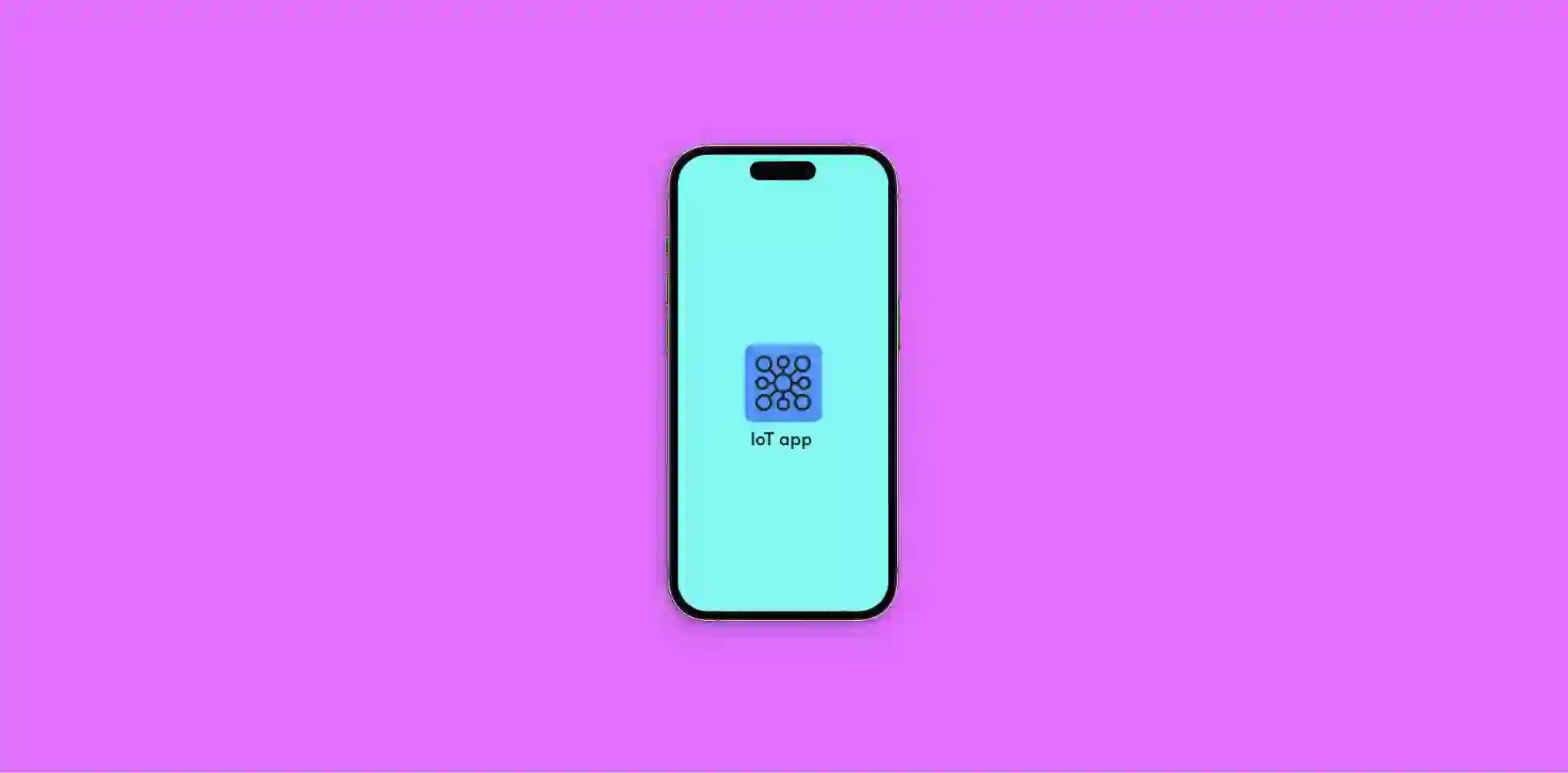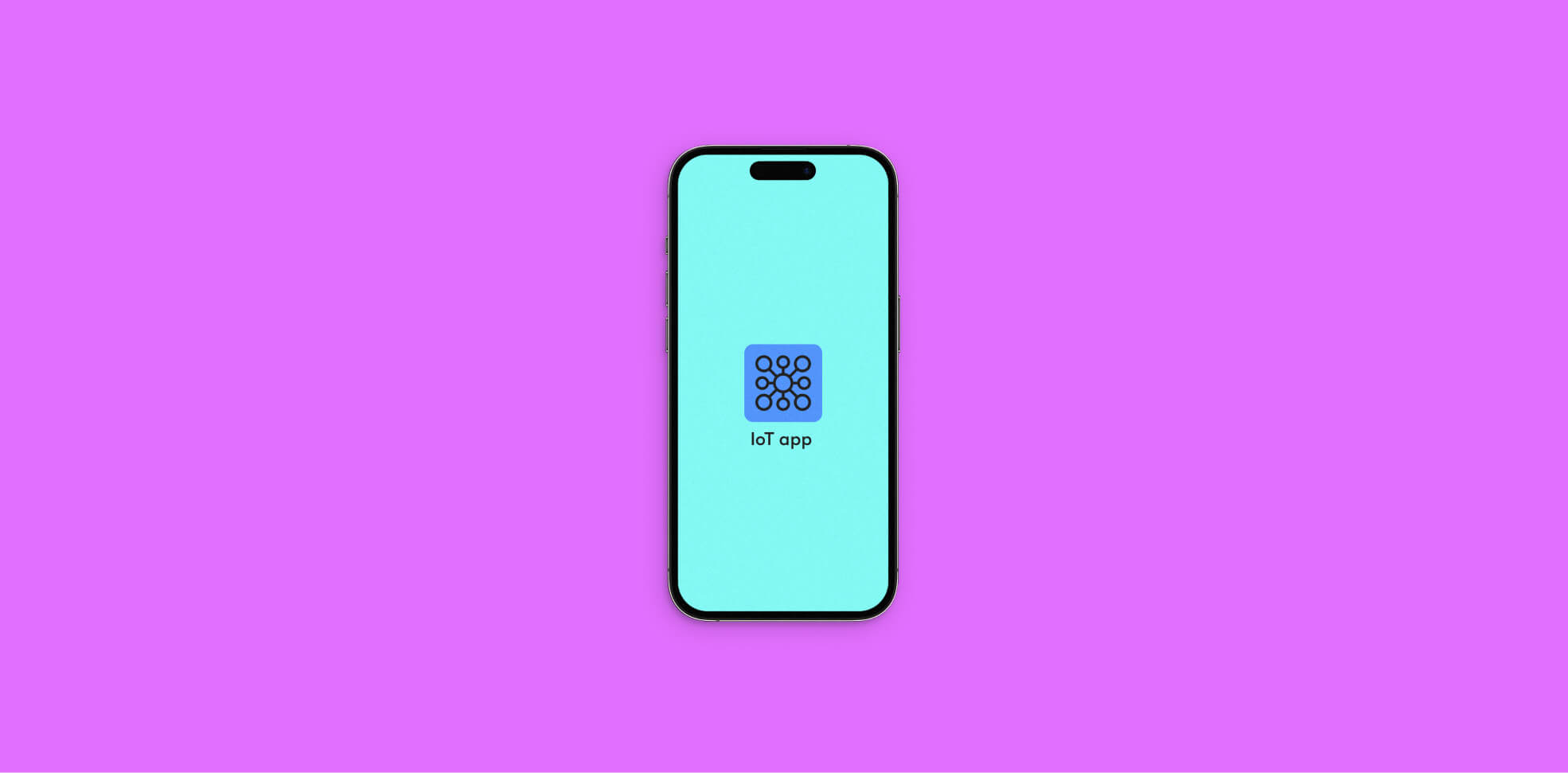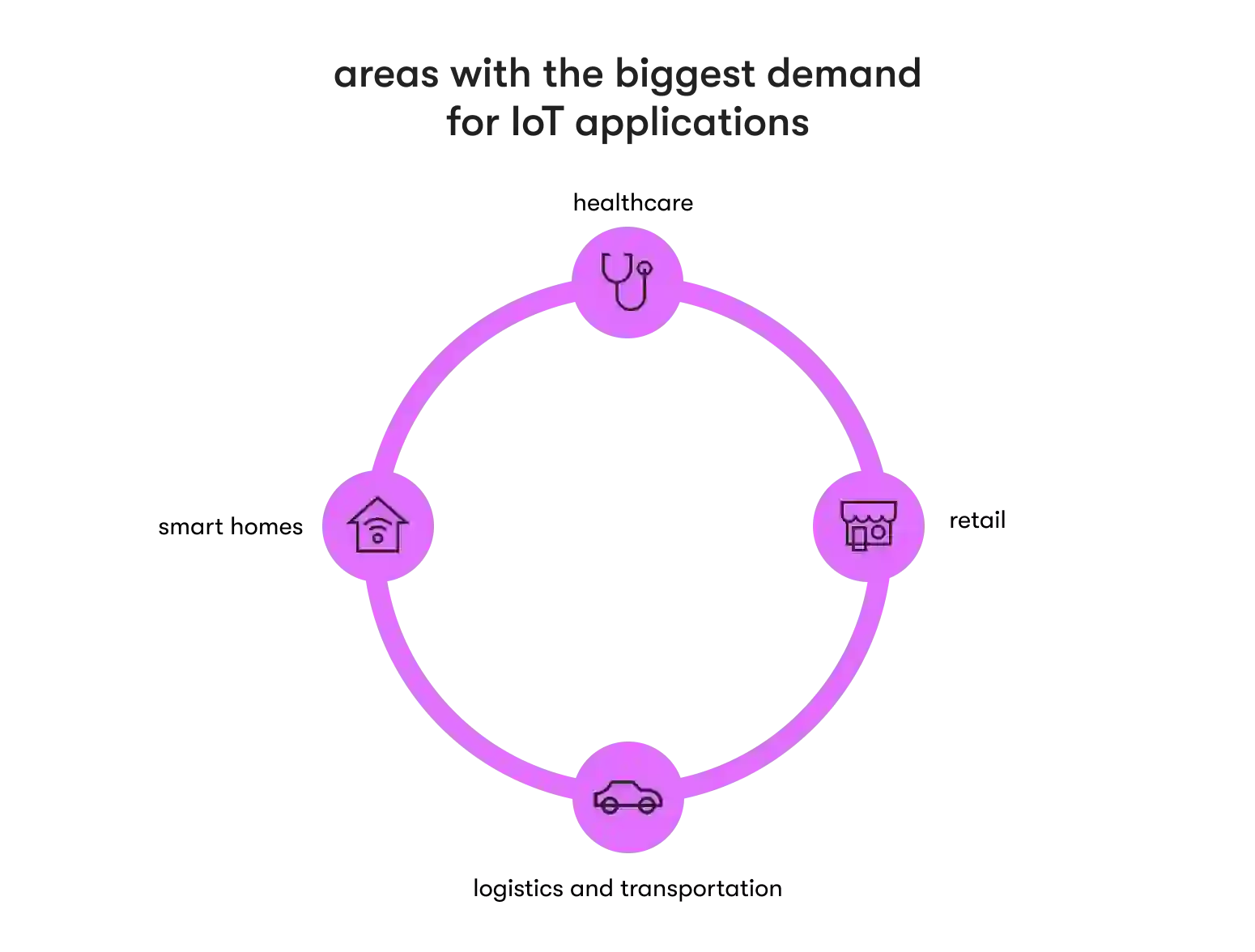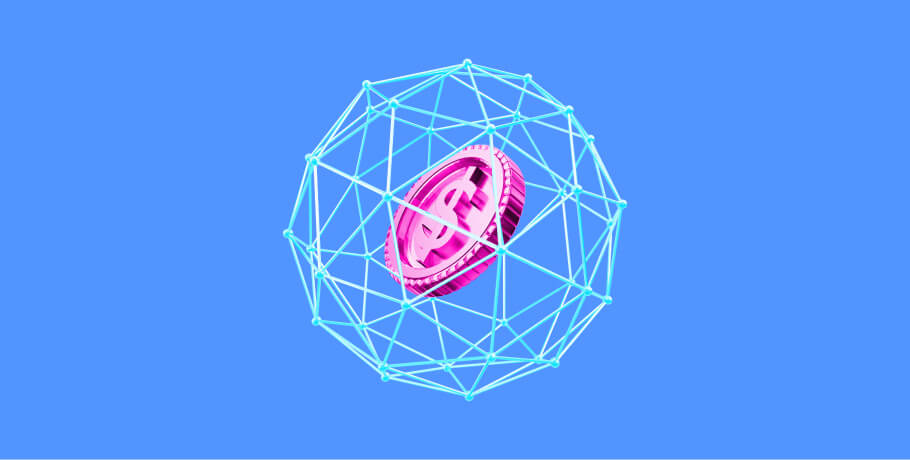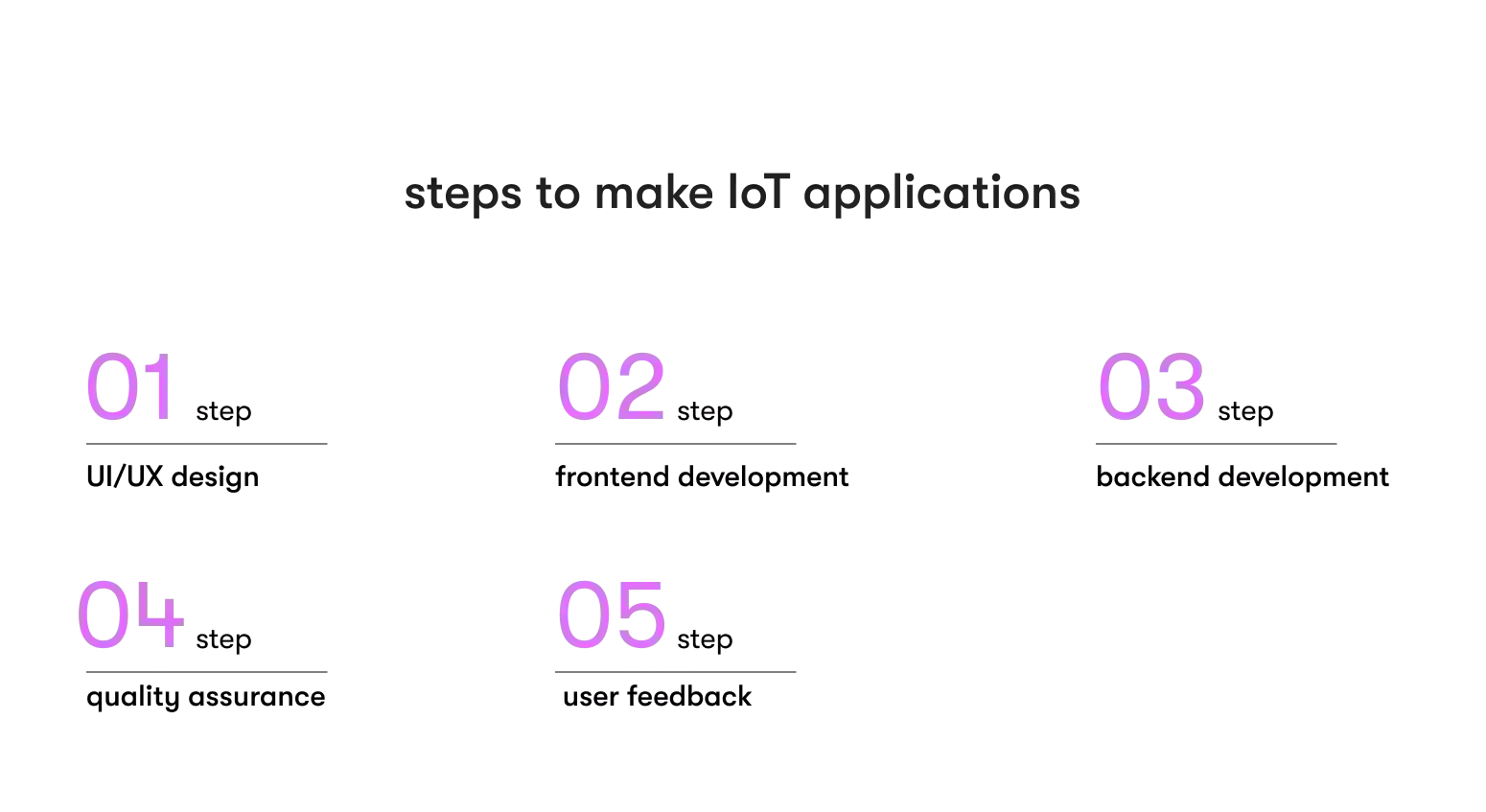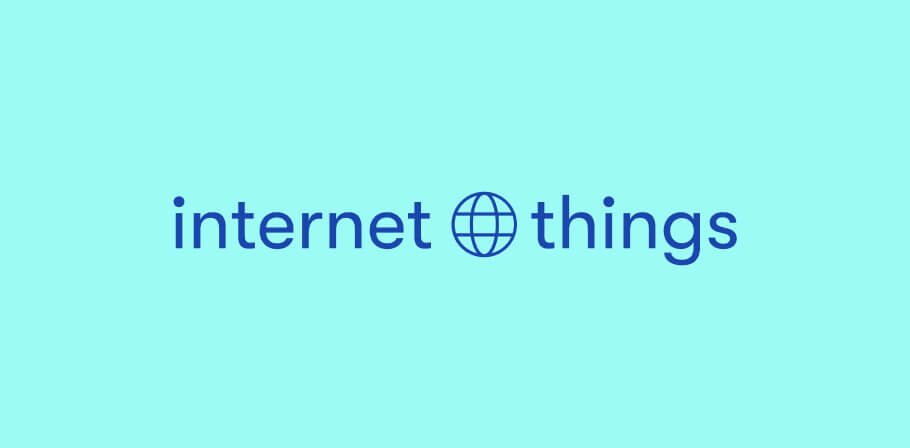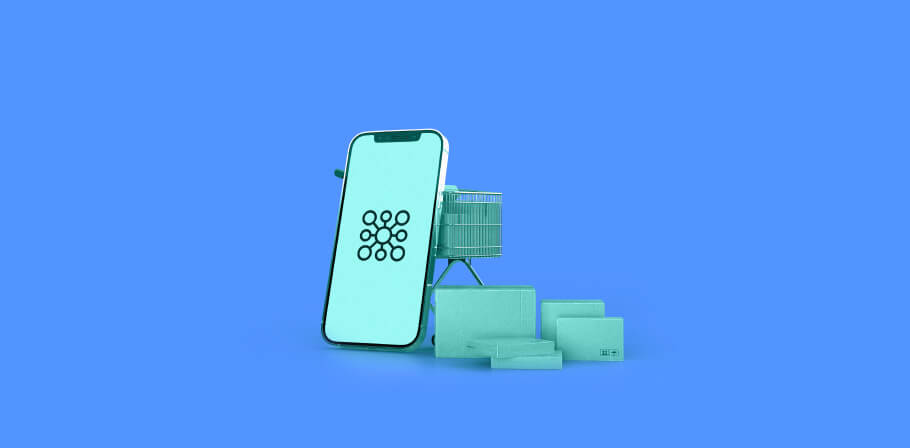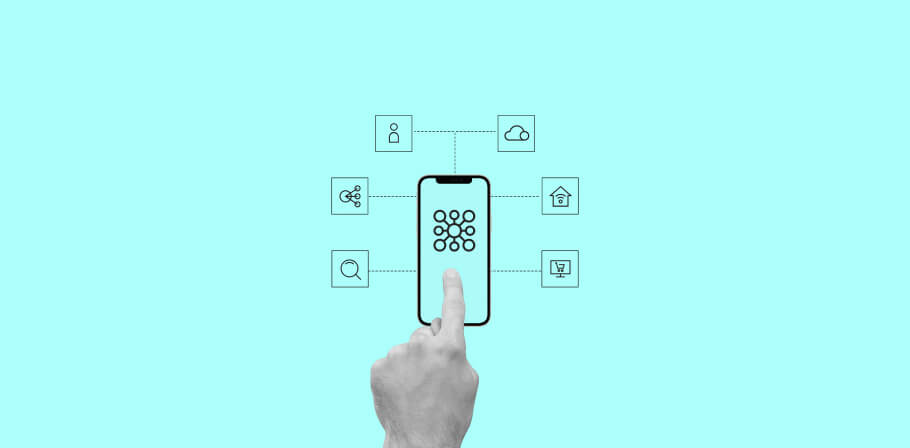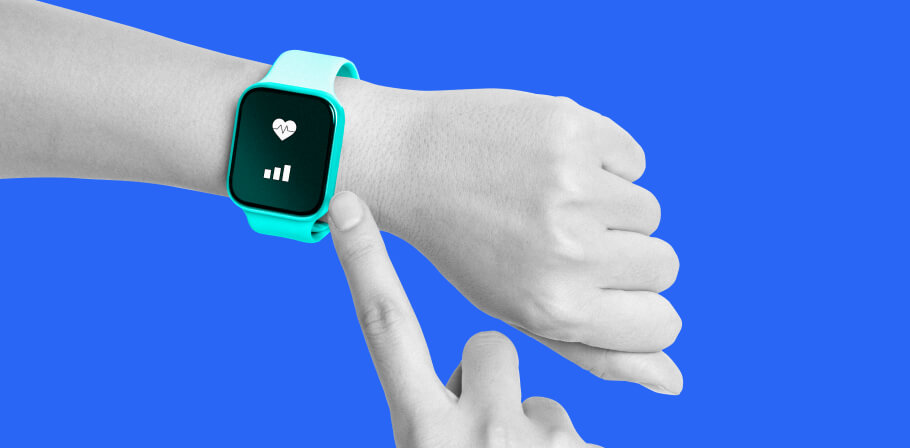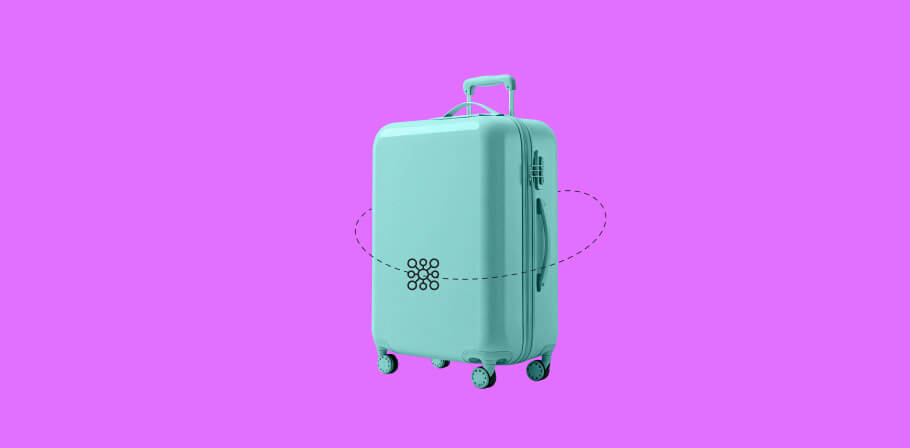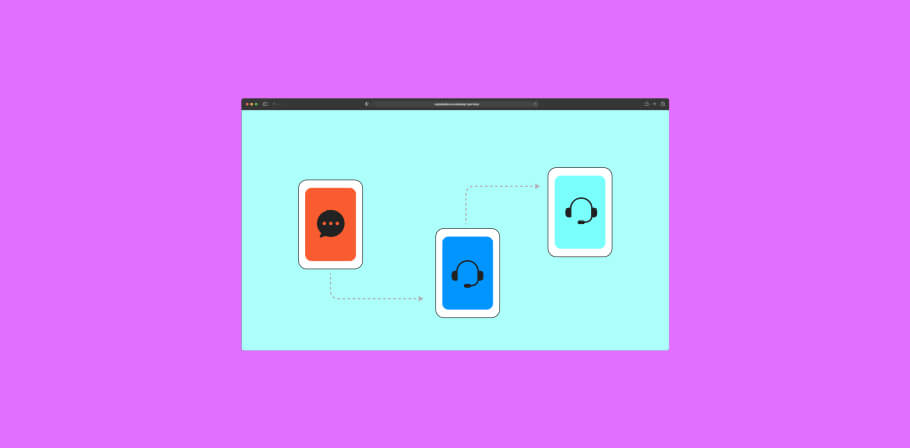IoT app development is the process of creating applications that enable the interaction and management of Internet of Things (IoT) devices. This involves integrating hardware, software, and network technologies to facilitate seamless communication and data exchange between connected devices and users. Effective IoT app development ensures robust functionality, security, and scalability for a wide range of applications across industries.
The internet of things (IoT) is already changing the way we function on a daily basis, and that’s what makes IoT app development so enticing. The variety of use cases is far beyond what many expect, creating opportunities to remove a range of tasks from the hands of employees. But that’s not all — internet of things app development can also make consumers’ lives better through smart home solutions, wearables for health tracking, and similar advancements.
But what is IoT exactly? In the simplest sense, the internet of things involves physical devices equipped with sensors, software, and other technologies that have the ability to connect and exchange data with other devices and systems via the internet or other networks, like Wi-Fi or Bluetooth.
IoT technology has a huge impact not only on individuals but also on business and society in general, and interest in the technology — along with IoT application development — only continues to increase.
According to Statista, the number of connected IoT devices will grow from 15.14 billion units in 2023 to 29.42 billion units in 2030. That data indicates more demand for IoT apps and devices and, consequently, space for more companies that focus on IoT application development.
If you want to know more about how to develop IoT applications, keep reading to learn more about the ideal software development process for connected devices.
We’ll cover:
- Why startups decide to create IoT applications.
- Whether it’s better to build an IoT web application or IoT mobile application, and why.
- Which tech stack you should choose for IoT development.
- How to create an app for IoT that earners user loyalty.
- How much it costs to develop an IoT app in 2024
- Building IoT apps with enterprise-level experts like EPAM Startups & SMBs.
Areas with the biggest demand for IoT applications
IoT solutions impact not only the lives of individuals but also society in general. What are some of these impacts? First of all, think about a smart home concept (or smart cities in the broader sense), biometric scanners, wearable health monitors, voice assistants (like Siri), or smart cars (like Tesla). All of these examples of IoT are making a huge difference in the way we live, work, eat, train, and function.
IoT software and hardware can support an array of use cases beyond those above. For example, IoT in travel is also gaining traction, while IoT in telecom is continuing to make bigger waves. Big data and IoT together are also revolutionizing many industries.
Here, we’ll describe a few specific areas where IoT is particularly exciting, focusing on those with significant demand and the highest potential return on investment in development.
We’ve also added relevant examples of successful startups in the IoT industry, together with opportunities that each particular niche offers. You can treat it as inspiration to learn more about what’s possible.
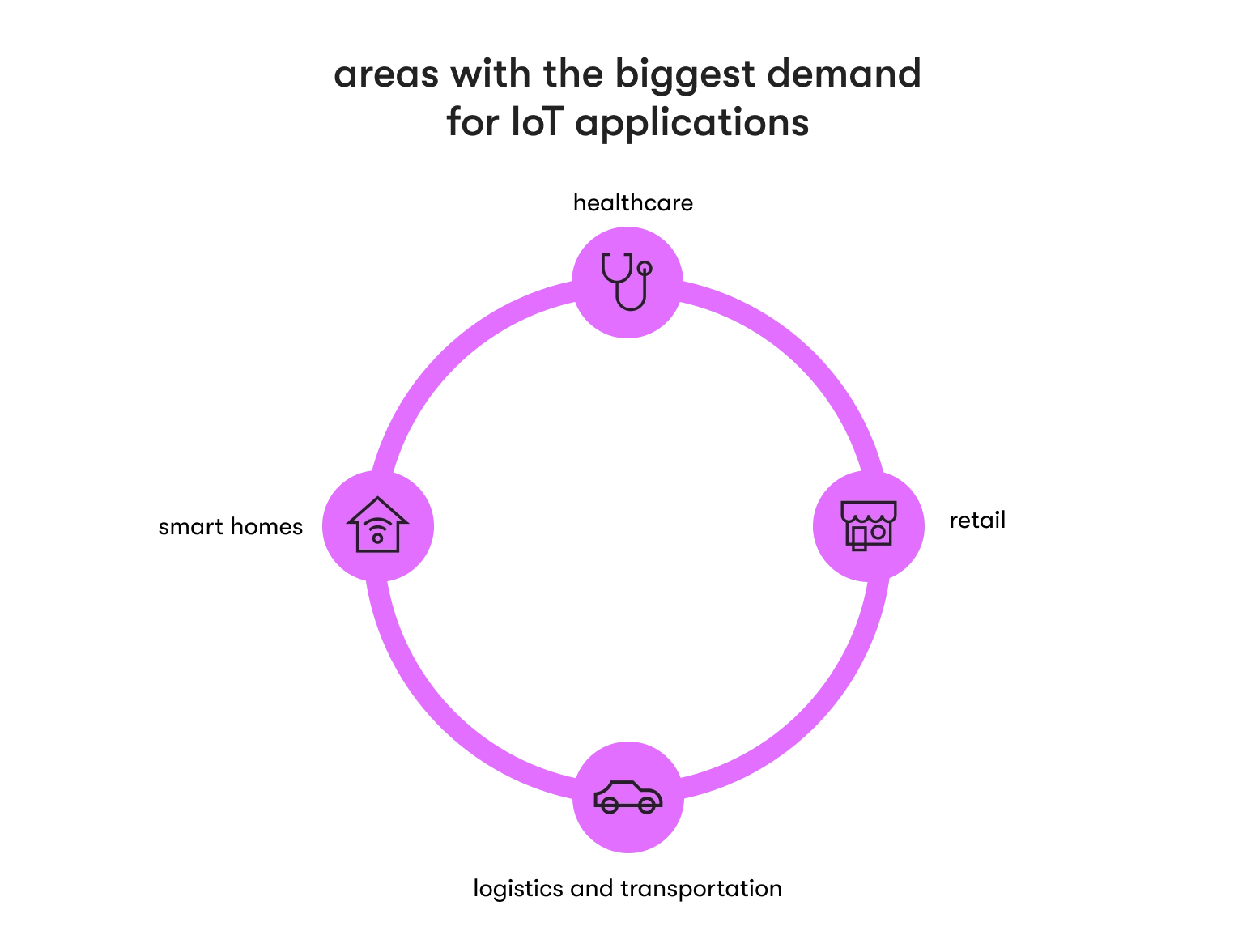
Healthcare
IoT in the healthcare industry helps medical professionals take better care of their patients. Additionally, it allows healthcare professionals to connect with patients proactively or in a timely manner based on data received.
Examples of IoT usage in healthcare
- Wearable health monitoring devices
- Sleep trackers and monitors
- Glucose monitors
- Real-time medical and monitoring equipment (like wheelchairs or defibrillators) tracking
- Smart medication dispensers
Startups and their IoT applications for healthcare industry
- Aira uses the latest IoT technologies to connect blind people with highly-trained professionals who help them with daily activities by providing visual information.
- AliveCor offers two products (KardiaMobile and Kardia Mobile 6L) for monitoring heart conditions.
- AwarePoint provides IoT sensors to track the locations of patients and medical equipment in real-time.
- Kinsa offers various smart thermometers as a way to detect contagious illnesses early.
- Medisafe is a medication reminder app available on Android and iOS.
Logistics and transportation
IoT helps optimize logistics and transportation processes of goods and people by tracking objects and vehicles as well as by transferring current data about the transports. IoT can also be used to control elements of the transport process remotely.
Examples of IoT usage in logistics and transportation
- Warehouse management
- Supply chain management
- Automotive tracking
- Finding alternative routes
- Predictive analytics for route planning and driver effectiveness tracking
- Traffic management
Startups and their logistics IoT applications
- HERE Tracking is a software for indoor and outdoor tracking of devices and assets that EPAM created together with HERE Technologies.
- Hopstack enables warehouse automation via IoT sensors.
- InnoTech simplifies package condition management.
- IOTech is a solution integrating retail and logistics via a sensor platform.
- Syook provides fleet tracking sensors as a solution called TiTo (Truck in Truck out).
- Tive is solution for tracking the location of high-value goods.
Retail
IoT in the retail industry can be used to improve both customer experience and retail management, making it easier, better, and faster. IoT in retail is also a way to provide digital experiences for customers visiting physical stores, while IoT in ecommerce can streamline online shopping operations.
Examples of IoT usage in the retail industry
- Retail management and tracking
- Optimization of product placement
- Improvement of customer experience (i.e., using IoT to detect confused or impatient customers and informing in-store staff about them)
- Inventory management
Startups and their retail IoT applications
- EVRYTHNG provides data on company-owned or manufactured products and is being used by brands like Ralph Lauren and Coca-Cola.
- CONEX assists with smart visual merchandising and quality images for interactive displays.
- Stockwell is a manufacturer of vending machines called smart stores, that can be adapted to the particular space. For example, fitness clubs can fill vending machines with post-workout products.
Smart home
Using the internet of things in homes is about controlling domestic appliances remotely and, if needed, automatically. In other words, using IoT apps and smart devices allows for almost total control over a house and its surroundings (like a garden) without the need to be there physically.
Examples of using IoT in the smart home industry
- Energy usage control system
- Lighting and audio control systems
- Noise, water damage, smoke, and fire detectors
- Remote-controlled handles and curtains
- Garden watering system
Startups and their smart home applications
- SimpliSafe provides home IoT security solutions for detecting potential intruders, water damage, and fire and providing notifications when events are detected.
- Span.io offers smart electrical panels that consumers can connect to an app on their smartphones, allowing them to control energy usage at home.
- SmartRent creates smart home products and solutions dedicated to those renting properties and homebuilders.
- LinpTech is a manufacturer of smart doorbells and curtains for both residential and commercial buildings
Creating an IoT application: mobile app or web app?
If you’ve already chosen a niche for which you want to build an IoT app, it’s time to decide whether it’s better to make a mobile application or a web application.
Why it’s better to build a mobile app vs web app
- Better discoverability, as you can add your app to AppStore or Google Store
- Better accessibility to the device’s features and resources (and that means greater functionality)
- Better security, as mobile apps must be approved before being added to the app store
- Mobile apps can work without an active internet connection, i.e. via Bluetooth
- IoT mobile app development is usually faster and easier than IoT web application development
Why it’s better to build a web app vs mobile app
- Web apps work straight in a browser, so it’s not necessary to download them
- There is no need to build two separate apps, which might be the case if you want to develop a mobile app due to compatibility issues across multiple operating systems
- They are easier to maintain and update
- They don’t have to be approved by an app store, so you can launch more quickly
PARTNER WITH IOT EXPERTS
Contact EPAM Startups & SMBs — a leading IoT app development company — to get help from our team.
What’s under the hood: build an IoT application using these components
Every internet of things application requires four elements: cloud technology, dedicated hardware, a reliable network, and intuitive software.
Cloud
One of the most critical elements of IoT that is responsible for data processing and storage.
Hardware
Low-energy sensors or mobile devices that can be either custom-built or bought from third-party vendors.
Network
Responsible for two-way communication between all relevant IoT devices, IoT gateways, and other components in the IoT ecosystem and properly linking these devices with each other.
Software
Responsible for managing all devices within an IoT system. Whether you choose to develop a mobile app or a web app, the software should be cloud-based. Additionally, users should be able to check information collected from sensors and devices via one dashboard, and APIs should be leveraged appropriately.
The tech stack you need to create a winning IoT application
The technology stack needed to create an IoT app consists of the following: programming language, framework, cloud IoT platform, protocol, hardware, and sensors. Combine them according to your specific tech requirements, and if uncertain, don't be shy about reaching out to our experts for IoT consulting and professional solutions.
Programming languages
- C/C++
- JavaScript
- Python
- Ruby
Frameworks
- Node.js
- IoT.js
- Device.js
- Angular
Cloud platforms
- Arduino (open source)
- AWS (Amazon Web Services) IoT
- Google Cloud IoT
- IBM Watson
- Microsoft Azure IoT
- OpenHAB
Protocols
- 2G/3G/4G/LTE/5G
- AMQP
- MQTT
- Wi-Fi
Hardware
- Arduino
- FPGA controllers
- Google TPU
- Raspberry PI
Sensors
- 1-Wire
- ADC
- Analog
- RF433
- RFID
How to make an IoT application that users will love
At EPAM Startups & SMBs, we advise you to build a minimum viable product to verify your idea as fast as possible and improve it according to the feedback you receive from initial customers.
And when it comes to the development process itself, we’ve prepared a list of recommended steps to implement when building high-quality IoT products, ones that people will keep using again and again.
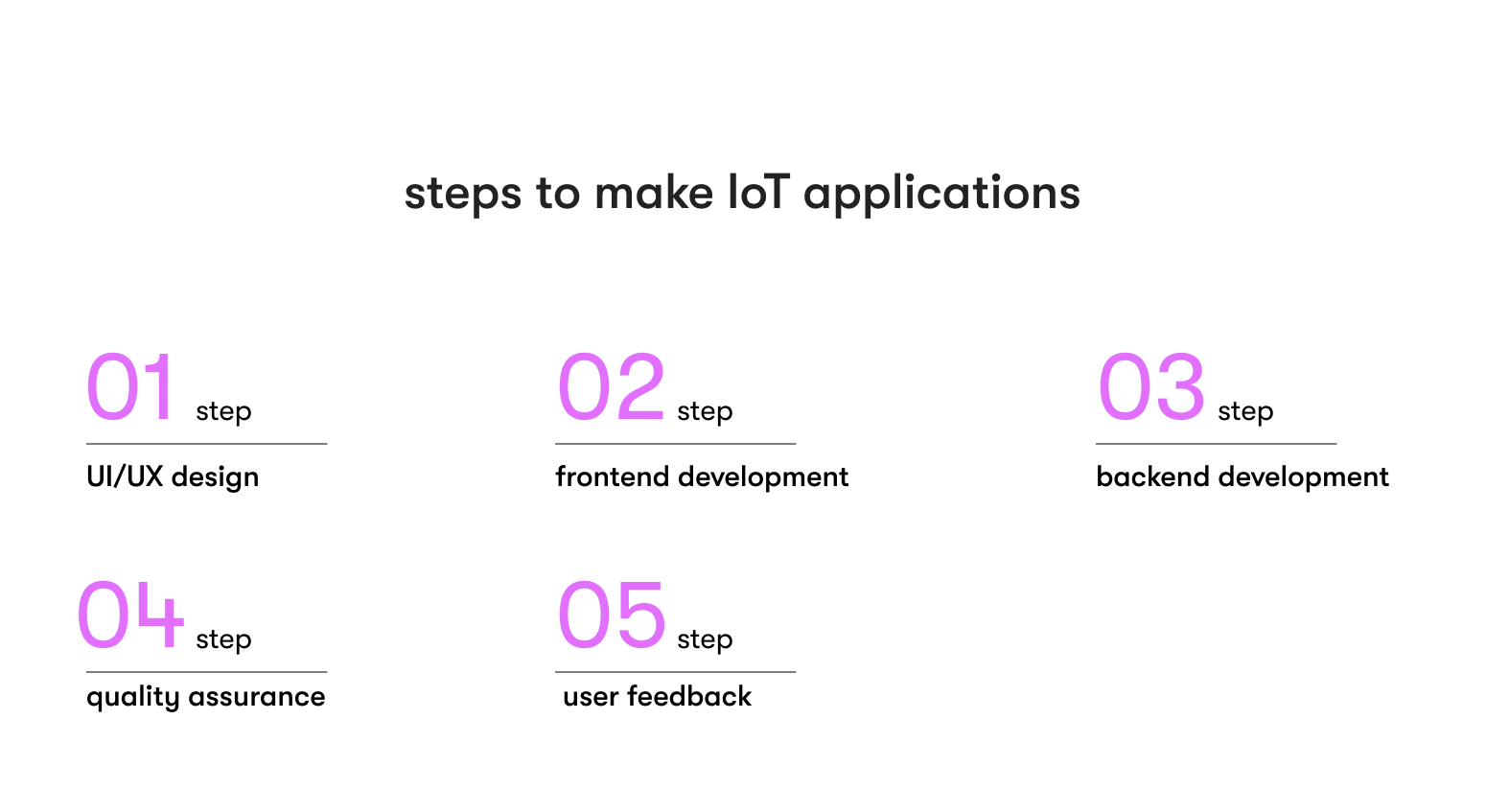
Step 1: UI/UX design
An IoT app — like any other app — needs a design that’s not only good-looking but also user-friendly, as that can help your applications stand out in the broader IoT market. Experienced product designers can help ensure the user interface is set up correctly.
Before you start the IoT mobile app or web app development process, you need to know how important a good UI/UX design is — it’s what separates successful apps from those that get removed quickly. For example, disappointed people will leave bad reviews on AppStore or Google Play, and that will have a harmful effect on the number of downloads.
In your internet of things app, make sure that the user flow is logical and there are no errors like buttons leading to nowhere. For the end user, using your app should feel natural and intuitive without unnecessary guesswork or frustration.
Step 2: frontend development
One of the most popular programming languages for frontend development is JavaScript. There are many frameworks built upon JS, like Angular, React, or Vue, that boost the software development process and provide front end developers with a great programming experience. Choosing one usually depends on individual preferences, experience, or requirements of the particular project (or a combination of these factors).
Step 3: backend development
Backend development is a bit more complicated, as you need to choose more tools that must be compatible with each other. We already covered cloud platforms before, but you must also select a programming language, database management system, and DevOps tools.
If you decide to go with JavaScript to build a frontend layer, then the natural choice for backend programming would be Node.js, as it’s also built upon JavaScript.
- Database — CrateDB, InfluxDB, MongoDB, RethinkDB, SQLite Database
- DevOps tools — Gradie, Jenkins, Docker
Step 4: quality assurance — automated or manual testing
Before launching, test your application to discover as many bugs as possible and fix them. Do the same with vulnerabilities, as offering a secure app is essential. Also, be prepared to receive bug reports from the users and to address any identified concerns quickly.
Step 5: collect users’ feedback and improve your app accordingly
After launching your app, listen to your initial users, collect their feedback, and create a roadmap describing what fixes or new features will be implemented and when. Make this roadmap available to your users so they know you treat them seriously and that you intend to improve your app over time.
Prioritizing Data Privacy and Security in IoT Application Development
In developing IoT applications, prioritizing data privacy and security is essential. Key measures to ensure robust security include:
- End-to-End Encryption: Safeguarding data from the device level to the cloud.
- Regular Security Audits: Continuously assessing vulnerabilities and potential threats.
- Compliance with Data Protection Laws: Adhering to regulations such as GDPR and CCPA.
- Secure User Authentication: Implementing strong authentication mechanisms.
- Data Anonymization Techniques: Protecting user identities and sensitive information.
- Real-Time Security Monitoring: Detecting and responding to threats promptly.
These practices are crucial for building user trust and maintaining the integrity of IoT ecosystems.
How much does it cost to make an IoT app in 2024?
Before diving into the average rates for developing IoT applications, it’s essential to understand what factors determine the final price. This includes:
- App complexity (i.e., number of features, integration of artificial intelligence or machine learning, etc.)
- Application security level, authentication technologies, and security features
- Number of API integrations
- Operating system
- Type of application (mobile or web)
- UI/UX design complexity (i.e., how many screens need to be coded)
That said, here’s the breakdown of the cost benchmarks based on the market averages at the moment:
- The cost of developing a small and simple IoT app starts from $80,000.
- The cost of developing a medium, more advanced IoT app starts from $100,000.
- The cost of developing an advanced app with multiple features starts from $150,000.
talk to our experts and get a free quote for your IoT app project
Developing applications for the internet of things with EPAM Startups & SMBs
Working with EPAM Startups & SMBs — a leading IoT app development company — means:
- Great user experience — usability of IoT apps is something we take very seriously from day one, as there is no point in building any app that won’t be user-friendly.
- Broad expertise — for every project we take on, we assemble a development team of people with the most relevant skills and experience.
- High-level app security — we make sure that app data will be stored and well-protected at every level.
- Scalability — thanks to our microservice-based architecture, there is always the ability to scale IoT applications by adding new features or integrations and expanding a list of supported devices.
Conclusion
This article is intended to acquaint you with the fundamentals of how to create IoT applications. We’ve covered things like industries with high demand for IoT apps, components of the internet of things, the right tech stack, and a step-by-step process for building apps people will use. As the demand for IoT applications keeps growing globally, more and more companies will try to jump in and secure their positions in verticals like retail or healthcare.
let’s build your user-winning IoT app together
FAQ

Expert digital communicator and editor providing insights and research-based guides for technology buyers globally.
Expert digital communicator and editor providing insights and research-based guides for technology buyers globally.
Explore our Editorial Policy to learn more about our standards for content creation.
read more